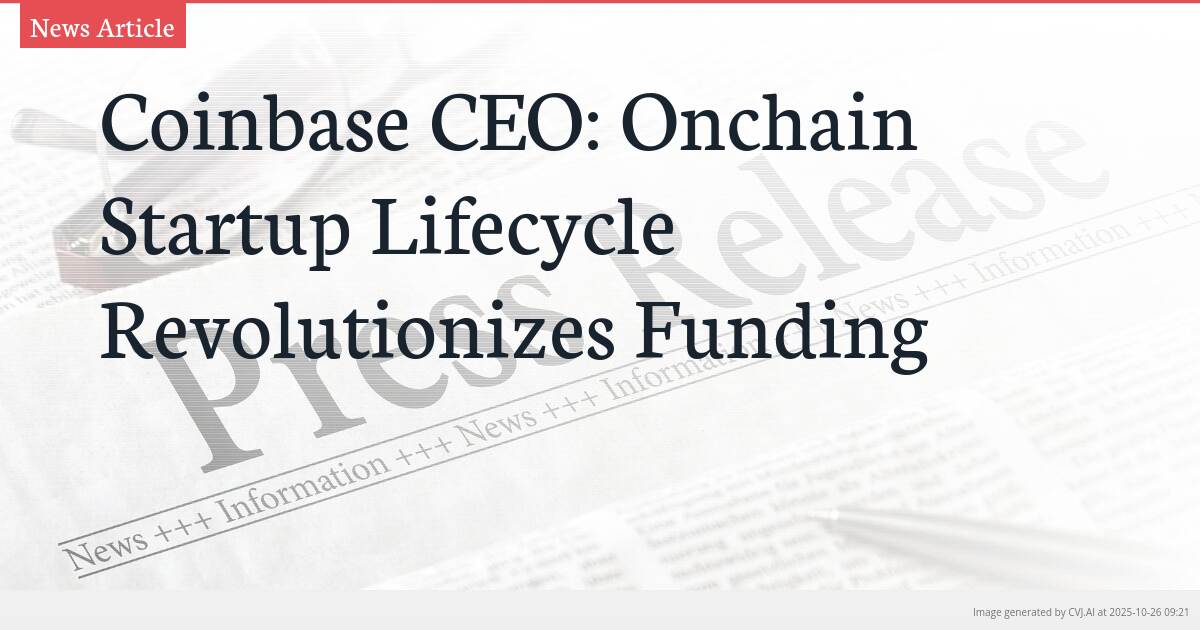This summary text is fully AI-generated and may therefore contain errors or be incomplete.
Introduction
Coinbase CEO Brian Armstrong has unveiled an ambitious vision to transform how startups raise capital and operate by moving their entire corporate journey onto blockchain technology. Speaking on the TBPN podcast, Armstrong described how companies could incorporate, raise seed funding, receive instant capital in USDC stablecoin, and eventually conduct public offerings through tokenized equity. This radical reimagining of capital formation promises to make startup funding more efficient, fair, and transparent while dramatically increasing accessibility for entrepreneurs worldwide.
Key Points
- Startups could complete entire corporate lifecycle onchain from incorporation to public trading
- Funding would occur through instant USDC transfers rather than traditional banking channels
- Public offerings would utilize tokenized equity instead of conventional stock market listings
The Onchain Corporate Lifecycle Vision
Brian Armstrong’s vision represents a fundamental shift in how startups could operate from inception to maturity. The Coinbase CEO articulated a comprehensive framework where every stage of a company’s development would occur onchain, beginning with incorporation and extending through to public trading. This approach would eliminate many of the traditional barriers that startups face when navigating the complex world of corporate governance and capital raising. Armstrong specifically highlighted how this system could “increase the number of companies who go raise capital and get started out there in the world,” suggesting that blockchain technology could democratize entrepreneurship on a global scale.
The proposed onchain lifecycle would fundamentally restructure how startups interact with investors and regulatory frameworks. Instead of navigating multiple jurisdictions and complex legal structures, founders could leverage smart contracts and blockchain-based governance to streamline operations. Armstrong’s vision positions blockchain not just as a financial technology but as a comprehensive corporate infrastructure that could replace traditional legal and financial intermediaries. This represents a significant evolution from current blockchain applications, moving beyond cryptocurrency trading to encompass the full spectrum of corporate operations.
Revolutionizing Capital Formation with USDC
At the heart of Armstrong’s proposal lies a radical transformation of how startups access funding. The Coinbase CEO specifically emphasized the role of USDC stablecoin in enabling instant capital transfers during seed rounds and subsequent funding stages. This approach would eliminate the delays and friction associated with traditional banking systems, where wire transfers can take days to clear and international transactions face additional complications. By using USDC, startups could receive funding immediately, allowing them to deploy capital more efficiently and focus on growth rather than navigating financial logistics.
The use of USDC for onchain fundraising addresses several critical challenges in traditional capital formation. Stablecoins provide price stability while maintaining the speed and transparency of blockchain transactions, creating an ideal medium for startup financing. Armstrong’s emphasis on USDC specifically, rather than volatile cryptocurrencies, demonstrates a pragmatic approach to blockchain adoption that prioritizes functionality over speculation. This focus on stablecoin integration suggests that Coinbase sees practical utility as the key driver for broader blockchain adoption in corporate finance.
Armstrong’s vision extends beyond simple payment processing to encompass the entire fundraising ecosystem. The transparency of blockchain transactions could provide investors with unprecedented visibility into how their capital is being deployed, while smart contracts could automate compliance and reporting requirements. This combination of instant settlement in USDC and automated governance could significantly reduce the administrative burden on early-stage companies, allowing founders to concentrate on building their businesses rather than managing complex financial operations.
Tokenized Equity and Public Markets Evolution
The final stage of Armstrong’s onchain vision involves transforming how companies go public through tokenized equity. This approach would replace traditional stock market listings with blockchain-based tokens representing ownership stakes, creating a more accessible and efficient public market infrastructure. Tokenized equity could enable fractional ownership, lower barriers to investment, and provide greater liquidity for both companies and investors. Armstrong’s proposal suggests that the benefits of blockchain technology could extend well beyond private fundraising to revolutionize public capital markets.
The transition to tokenized equity represents perhaps the most ambitious aspect of Armstrong’s vision, as it would require rethinking decades of established market infrastructure and regulatory frameworks. However, the potential benefits are substantial: reduced settlement times, lower transaction costs, and global accessibility could make public markets more efficient and inclusive. Armstrong’s comments indicate that Coinbase sees this evolution as inevitable, with blockchain technology poised to transform not just how companies raise initial capital but how they maintain relationships with public market investors throughout their lifecycle.
This comprehensive approach to onchain corporate development reflects Armstrong’s belief in blockchain as a foundational technology rather than merely a financial innovation. By connecting incorporation, private fundraising, and public markets through a unified blockchain infrastructure, the Coinbase CEO envisions a future where entrepreneurs can focus on building their businesses rather than navigating complex legal and financial systems. While significant regulatory and technical challenges remain, Armstrong’s vision provides a compelling roadmap for how blockchain could transform entrepreneurship and capital formation in the coming years.
📎 Read the original article on cointelegraph.com

